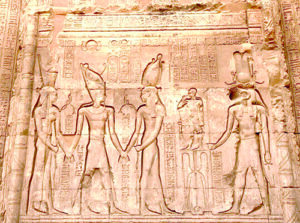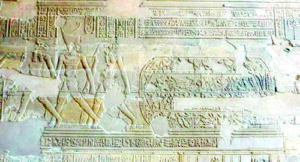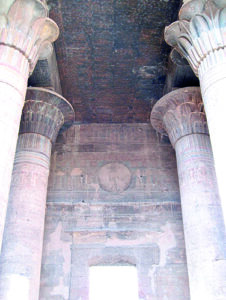Khnum is a ram-headed god who fashioned humankind on his potter’s wheel. Ptolemy VI Philometor (180–45 BC) started the construction of Khnum’s temple in Esna in southern Egypt.
The Romans added the hypostyle hall, the only part of the temple that is excavated and can be visited today, with well-preserved carvings from as late as the 3rd century AD.
The Temple of Khnum today sits in a 9 metre-deep pit, which represents 15 centuries of desert sand and debris. This sand accumulated since the temple was abandoned during the Roman period.

Most of the temple, similar in size to the temples of Edfu and Dendara, is still covered by the old town of Esna.
A quay connecting the temple to the Nile was built by Roman emperor Marcus Aurelius (AD 161–180).
The central doorway leads into the dark, atmospheric vestibule, where the roof is supported by 18 columns with wonderfully varied floral capitals in the form of palm leaves, lotus buds and papyrus fans. Some of the floral capitals also have bunches of grapes, a distinctive Roman touch.
The roof is decorated with astronomical scenes, while the pillars are covered with hieroglyphic accounts of temple rituals.
Inside the front corners, beside the smaller doorways, are two hymns to Khnum. The first is a morning hymn to awaken Khnum in his shrine; the second is a wonderful ‘hymn of creation’ that acknowledges him as creator of all, even foreigners: ‘All are formed on his potter’s wheel, their speech different in every region but the lord of the wheel is their father too.’

On the walls, Roman emperors dressed as pharaohs make offerings to the local gods of Esna.
The northern wall has scenes of Emperor Commodus catching fish in a papyrus thicket with the god Khnum and, next to this, presenting the temple to the god.
The back wall, to the northeast, constructed during the Ptolemaic period, features reliefs of two Ptolemaic pharaohs, Ptolemy VI Philometor and Ptolemy VIII Euergetes (170–116 BC).
A number of Roman emperors, including Septimus Severus, Caracalla and Geta, added their names near the hall’s rear gateway.
The Temple of Khnum is situated about 200 meters from the boat landing, at the end of the tourist market.

The modern Egyptian village of Esna, which was ancient Iunyt or Ta-senet (from which the Coptic Sne and Arabic Isna derive), was built in the area of ancient Latopolis and is the site of a major temple dedicated to the god Khnum.
Under the Greeks and Romans, the city became the capital of the Third Nome of Upper Egypt. Besides Khnum, the temple was dedicated to several other deities, the most prominent of whom were Neith and Heka. This was the ram god that was worshipped throughout this area.
Esna is located about fifty kilometres south of Luxor. This proximity to Luxor makes Esna an interesting city for those obsessed with the ancient Egyptian civilization. Luxor has whatever tourists may need for a comfortable and enjoying stay. The city boasts a large number of hotels that suit all types of budgets. It also has restaurants that offer international and authentic Egyptian cuisine.
Luxor can easily be reached from Cairo by air and also by train. Egypt has already modernised most of its railways, making the trains very comfortable and safe for travellers.






Discussion about this post